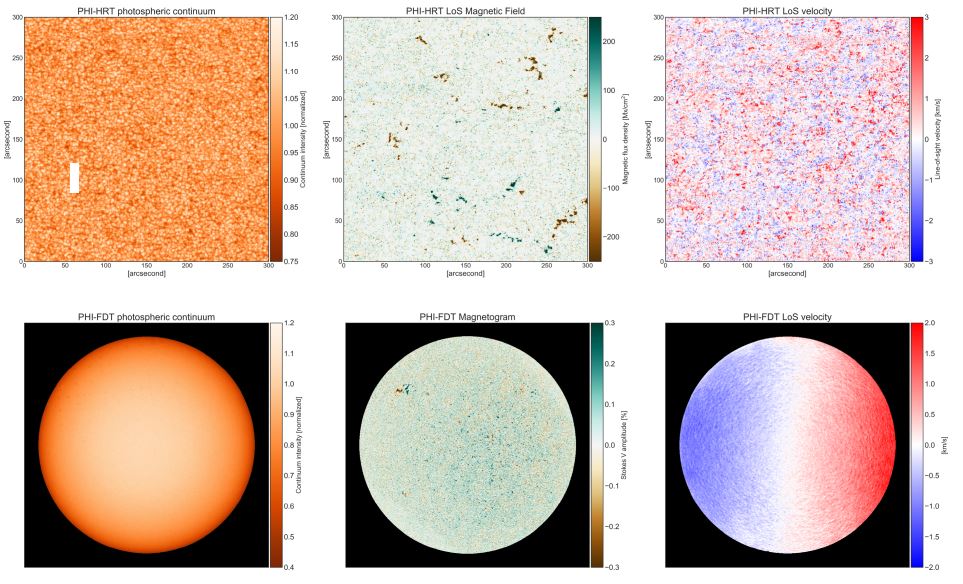The SO/PHI instrument, on board the Solar Orbiter mission, obtains the first autonomous magnetic map of the Sun
The first results obtained by the Solar Orbiter mission, developed by ESA in collaboration with NASA, will be presented on July 16th
The SO/PHI instrument, co-developed by the Instituto de Astrofísica de Andalucía (IAA-CSIC), has obtained the first magnetic map of the surface of the Sun without human intervention and from space
The Solar Orbiter mission, developed by the European Space Agency (ESA) with the participation of NASA, took off into its orbit around the Sun on February 9th. The mission was designed to observe the Sun from an unprecedented perspective and to study solar physics and the influence of the Sun on the interplanetary environment. A few months after the launch, it has already obtained its first scientific results, which will be presented at a press conference. Among them is the first magnetic map of the Sun obtained from space without human intervention, sent to Earth by the SO/PHI instrument, co-developed by the Instituto de Astrofísica de Andalucía (IAA-CSIC).
Solar magnetic field by SO/PHI SOLAR ORBITER/ PHI/ ESA/ NASA
The mission is now in its initial cruising phase, which will last until November 2021, when it will raise its orbital plane to reach high latitudes and provide the first quality view of the magnetic field at the poles. "The instruments on board the ship have not been inactive: they have just completed the first phase of tuning, in which activities have focused on checking that all the complex systems are working properly and, if deviations are observed, finding measures to resolve or mitigate them", said Jose Carlos del Toro Iniesta, a researcher at the Andalusian Institute of Astrophysics who is co-ordinating the SO/PHI instrument.
Solar Orbiter will rotate around the Sun in an orbit with a minimum distance lower than that of Mercury and outside the ecliptic, which will provide a unique perspective and will allow to observe the Sun's poles. In addition, its instruments will take both local and remote measurements, providing the first complete insight into both solar and heliospheric physics.
Solar Orbiter is the first space mission with Spanish leadership in two instruments: the EPD instrument, the energetic particle detector, led by the University of Alcalá and the University of Kiel (Germany), and the PHI magnetometer, led by the Max Planck Institute for Solar System Research (Göttingen, Germany) and the Instituto de Astrofísica de Andalucía (IAA-CSIC), in Granada.
SO/PHI: WHEN SCIENCE IS DONE IN FLIGHT
SO/PHI (Solar Orbiter/Polarimetric and Helioseismic Imager) is a polarimetric and helioseismic imager whose aim is to make a precise mapping of the solar magnetic field, responsible for practically all the phenomena we observe on the Sun, such as sunspots, solar storms or solar wind (a continuous flow of electrically charged particles emanating from the Sun and travelling through interplanetary space). SO/PHI will also measure the speed of the plasma in the photosphere, the innermost layer of the Sun's atmosphere and where the solar wind comes from.
SO/PHI has been built by an international consortium (45% Germany, 42% Spain, 10% France and the rest other countries). The Spanish part, which has developed, among other systems, the full disk telescope (FDT) and the electronic inverter of the radiative transport equation, has been coordinated from the IAA-CSIC, with the participation of the National Institute of Aerospace Technology (INTA), the Polytechnic University of Madrid, the University of Valencia, the University of Barcelona and the Instituto de Astrofísica de Canarias.
"The second row of SO/PHI images shows the entire Sun both in light intensity and in circular polarization. The Sun is in a period of low activity and no structures are visible in the intensity image, but we do observe magnetic structures on its surface in the circular polarization map. To obtain the first row of images we have used the high resolution telescope, which provides more detail and allows, on the one hand, to clearly distinguish the granulation (true bubbles of solar gas) and, on the other, provides the first autonomous magnetogram made in space", says Jose Carlos del Toro Iniesta (IAA-CSIC).
This autonomy is one of the unique features of SO/PHI, made possible by its electronic inverter, the first of its kind developed to date. Instead of sending the original data to the ground, this device allows science to be done on board: it converts measurements into maps of solar physical magnitudes, erases the former to free up memory and sends the latter to the operations centre. "Normally, such a map is obtained after tedious work carried out by fifty computers on the ground after a considerable time", concludes Jose Carlos del Toro Iniesta (IAA-CSIC).

Composition and explanation of the images: https://www.dropbox.com/s/mvsr7ftx0fcntqn/PRIMERA%20IMAGENES%20PHI-SOLAR%20ORBITER.pdf?dl=0
Images can be individually downloaded at the following link: https://www.dropbox.com/sh/39mh7zdhfzn129g/AADObQVOrNcQ3IoNI0hvRO1ka?dl=0
José Carlos del Toro jti@iaa.es 628 08 65 09
Instituto de Astrofísica de Andalucía (IAA-CSIC)
Unidad de Divulgación y Comunicación
Silbia López de Lacalle - sll[arroba]iaa.es - 958230532
http://www.iaa.es
http://www-divulgacion.iaa.es

